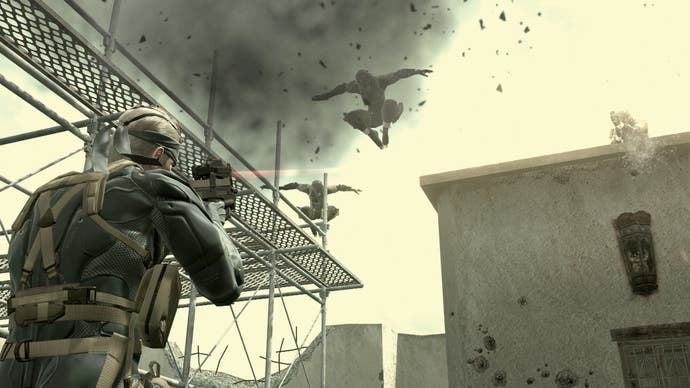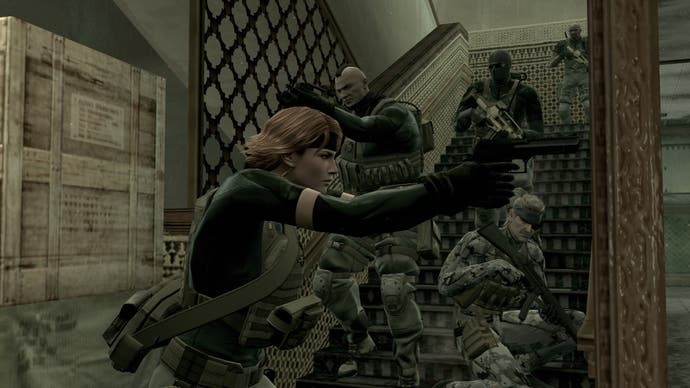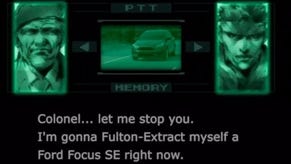Metal Gear Solid 4: Guns of the Patriots
The beginning of the end.
It begins with... well, we can't tell you how Metal Gear Solid 4: Guns of the Patriots begins. We can't, and we won't. Can't, because we promised Konami we wouldn't; having generously granted us three days to play through the whole thing, the publisher is understandably paranoid about spoilers, with the game still six weeks from release. Won't, because we want you to feel exactly the same delicious, hair-raising mix of bemused awe and shock-of-the-new that we did when you turn it on for the first time. Metal Gear Solid 4, it is instantly apparent, is special. It's not like other games.
That's not quite true, of course. There are a handful of other games it is like: its three predecessors, and, to some extent, the PSP's Portable Ops. Like its gruff hero Solid Snake, the series has always preferred to work alone. It may have been tremendously influential in establishing stealth gameplay, but none have ever dared imitate its bizarre and occasionally awkward blend of cinema and videogames, sneaking and soap opera, conspiracy and sex, bombast and self-deprecation, self-referential silliness and deadly earnest seriousness.
You couldn't even if you tried. And on this occasion, in a heroic effort to draw a line for once and all under Snake's story and give the Metal Gear Solid series the grand finale it deserves, Hideo Kojima and his team really have outdone themselves. 'Extravagant' doesn't cover it. Nor do 'dramatic', 'spectacular', 'sentimental', 'surprising', 'long-winded', 'final', 'painstaking' or 'polished'. Guns of the Patriots is Metal Gear Solid in excelsis.
Anyone who's familiar with the series - and any less than a rabid fan - will know that this is a mixed blessing. You have to put up with a lot to appreciate the fruits of Kojima's very personal and stubborn brand of auteur genius. This was never more true than it is of Metal Gear Solid 4. You have to subvert or repress many of your natural gaming instincts to safely negotiate its coldly exacting gameplay, and you have to leave the pad untouched through hour after hour of exposition and sermonising in cut-scenes and codec conversations. The latter take up a quite staggering proportion of the game's length; think the infamous MGS2: Sons of Liberty, and you won't be far wrong.

However, that's not the whole story. These cinematic episodes take on a different character in MGS4. For starters, they're all - with the exception of some fried eggs - rendered in real time by the game engine, allowing for some extremely slick transitions as the camera slips down to Snake's shoulder and plunges you into the scene.
Only once you appreciate this do you understand what a great visual achievement the game is, because only in the cut-scenes do you get close enough to truly appreciate how flawless, gorgeous and magnetically charismatic the in-game character models are, how exquisitely animated and well-rooted in their world. Yes, some textures are surprisingly low-resolution; yes there are aliasing issues and flickering shadows. But overall, Guns of the Patriots is handsome, moody and achingly cool, a real swoon-inducing matinee idol of a game. There's some terrific music, too.
Cut-scenes are also spiced with a little light interactivity. We discussed the flashback button on X, which gives fuzzy memory-flashes of moments in Metal Gears past when prompted, in our last preview. At other times, L1 provides a quick snap to an alternative, or first-person camera perspective. At one point in the first level, a drop of blood lands on Snake's shoulder, he looks up, and L1 gives you a startling close-quarters look at a Gekko - MGS4's terrifying breed of bioengineered, lowing bipedal mechs - with a soldier's corpse in its feelers.

Then there is the mission briefing that comes after the end of the game's first act. Taking place aboard Otacon's transport aircraft - effectively a base for the shy scientist and Snake, accompanied by child genius Sunny from MGS2 - this twenty-minute epic of plot exposition and subtle character development allows you to switch at will between a cinematic camera, the plane's CCTV circuit and a camera on board the Metal Gear Mk II, Otacon's remote-control robot alter ego. The Mk II can even be controlled, scooting around inside the cut-scene itself to find secrets or observe the tiny behavioural details of "off-camera" characters.
The mission briefing is a kind of interactive entertainment that only Hideo Kojima could have come up with. It's pointless and overlong but also a strangely spellbinding kind of downtime for player and writers alike, giving the game's characters time to breathe with some gentle comic interplay and moments of tenderness, and bridging the gap between cut-scene and game. You might end up frustrated with the amount of time you spend just watching Metal Gear Solid 4, but its cinematic side is so deeply embedded in the game this time that it makes for a much more coherent whole.









